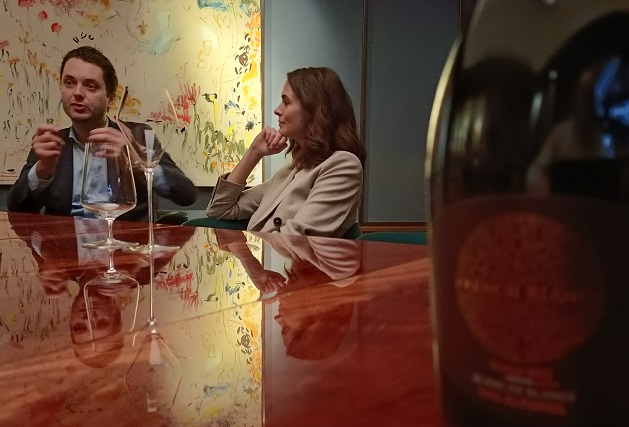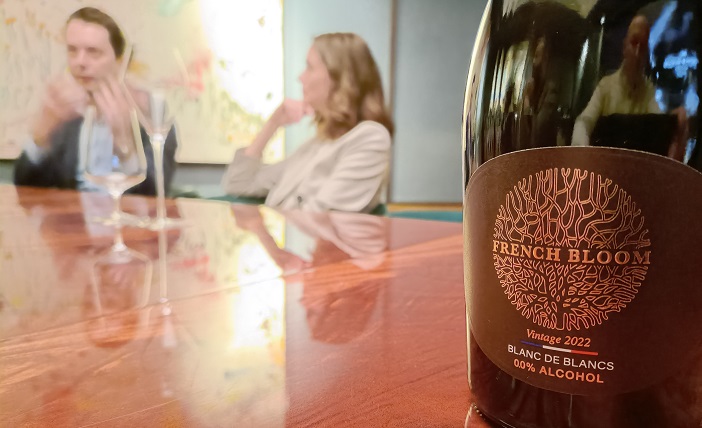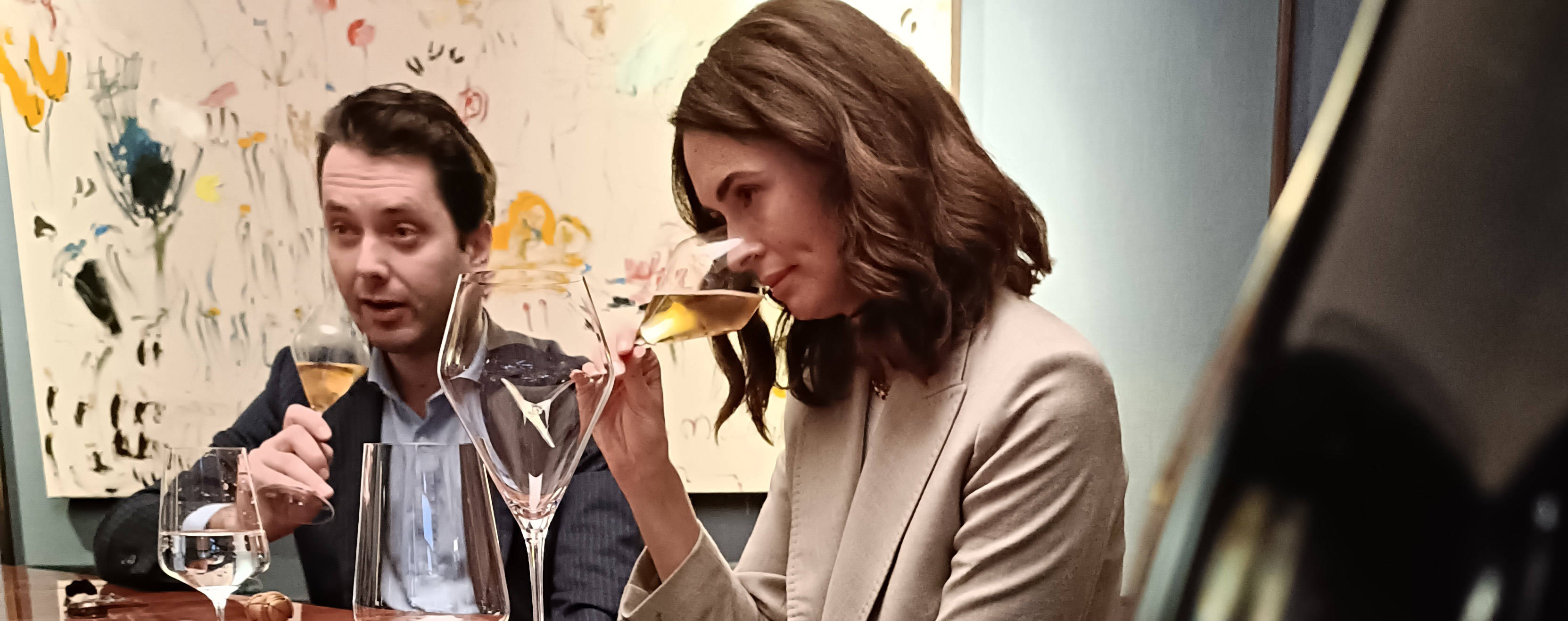The couple behind the French Bloom brand, Rodolphe and Maggie Frèrejean-Taittinger, made life even more complicated for themselves by insisting the wine should be made from organic grapes, be vegan-friendly, and contain no-added sulphites.
The result is French Bloom's La Cuvée 2022 – the world’s first 0.0% blanc de blancs vintage sparkling wine. I got to taste the wine with Rodolphe, a descendant of the Taittinger champagne dynasty and boss of Champagne Frerejean-Freres, and his wife Maggie, who was inspired to develop her own brand of non-alcoholic sparkling wine while pregnant with twins in 2019.
Their new sparkling wine hits the brief. It's organic, vegan-friendly, complex, enjoyable, and guilt-free! I can see it adding another dimension to pairing menus.


The wine, which is being sold in London department store Harrods for £109 and in the USA for $119, has been four years in the making. At the launch in London, Rodolphe and Maggie explain they began the development by dealcoholising premium wines from Burgundy, Bordeaux, and Champagne.
But Rodolphe, who oversees the winemaking, observes: “I think the biggest trap and the biggest mistake with alcohol-free wine is to think that a wine made to become a wine can be made alcohol-free... You can take the best wines of the world and dealcoholise them – it’s not good.”
Working with experts at Champagne House Frerejean Frères (which specialises in grand crus in Avize) and Coutanseaux Aîné in Cognac, Rodolphe says they quickly realised “we had to rethink completely our method of vinification”.
‘We have to exaggerate every step’The conclusion they came to was: “We have to exaggerate every step in order to deconstruct the wine… We have to create a base wine which is clearly undrinkable before dealcoholisation.”
“How undrinkable?” I ask.
Rodolphe explains you have to exaggerate everything by 60-70% to compensate for the losses. That means ripe grapes, acidifying and overly oaking the wine, while the lack of sulphites leads to a hint of oxidation that brings additional layers to the wine and helps mimic tertiary notes.
Even though it’s a young vintage – 2022 – Rodolphe says “we still want this feeling of having a very old sparkling wine, of ten or 20 years”.
He continues: “The biggest challenge was that we were tasting this base and from that base we had to extrapolate how it could become. So, it was working on the base, dealcoholising the base, working on the base, dealcoholising the base, a few hundred times.”
They kept pushing it until, “finally, after all those days, we eliminated a lot to keep just five of them and on those five (base wines) we’ve really been working intensively”.
The organic Chardonnay grapes are sourced from hilltop parcels from partner vineyards in the Languedoc region.
Maggie points out: “We dealcoholised wines from throughout France, including Burgundy, Bordeaux and Champagne, and we found that the wines of Languedoc were the best for what we were looking for – but more than that, Languedoc is the heart of the natural wine movement in France so there’s definitely, in terms of our winegrower partners, an openness, a willingness to follow our technical specifications which aren’t the technical specifications of the region.”
Languedoc is also one of the best regions in France for sourcing organic grapes – including Chardonnay and Pinot Noir.
Rodolphe describes Chardonnay from the region as “much more robust, with more shoulders, much more sun – which is a very good thing for dealcoholisation because we need Chardonnay with a lot of complexity and a lot of character”.
The grapes were harvested a couple of weeks before most Chardonnay producers in Languedoc started picking – when the grapes still had some acidity but also plenty of sugar. Even, so, the acidity was boosted with tartaric acid.
‘A new specification for a new way of making wine’“We are almost creating a new AOC. We are creating a new specification for a new way of making wine. And we realise this part of Languedoc is well fit for that,” Rodolphe declares while I’m thinking this could be a sustainable direction for grapegrowers faced with the full force of climate change.
The base wine was aged for eight months in new oak barrels. They did experiment with putting the dealcoholised wine back in barrels to age, but Maggie maintains this was “a disaster”.
Rodolphe adds: “We realised that the more we do before the dealcoholisation, the better it is. Most of the time in dealcoholised wine, they do a lot of make-up after the dealcoholisation. The idea here was to do as much as possible before and during the vinification to have this base wine which is as ok as possible and acidic as possible but to still be able to stand up after the dealcoholisation.”
The most difficult challenge was zero alcohol. Rodolphe says: “It was super-important for us to be at 0.0% to appeal to pregnant women and those who don’t drink alcohol. But it is also the hardest goal because at 0.5% it’s a big game-changer in terms of texture.”
The dealcoholisation is in three gradual stages – from 12% to 3%, to under 1%, to 0.0% – via a cold-temperature vacuum distillation process that removes the alcohol “in the most gentle way possible, which is super-important because it is a pretty harsh experience for the wine”, Rodolphe says.
The wine is stabilised through flash pasteurisation while the bubbles come from carbonating the wine to 6-bar pressure.
Tasting the wine at 67 Pall Mall, I’m impressed by the intense golden colour, the complex aromas with hints of dried apricots, caramelised nuts, prunes, baked fruits, star of anise, and the depth of the flavour. But mostly I’m surprised by the fine bubbles.
Maggie tells me: “We worked very hard to get that fine effervescence of 6 bars. That’s what’s so wonderful about this journey of La Cuvée – everything we’ve learned and the innovations we’ve made, we’re now going back to our core collection, our Le Blanc and Le Rosé (launched in 2021 in partnership with French model Constance Jablonski), and we’ll apply that same technique of effervescence.”
Apart from the fine bubbles, the other big surprise is the length of the savoury aftertaste. “The length is as important as the nose because it’s the last thing you are going to remember of the wine,” she reflects.
Rodolphe and Maggie see it as a gastronomic wine rather than as an aperitif – for “people who want quality when they’re not drinking alcohol”. 17,000 bottles have been produced. It sounds a lot to me, but they are on track to sell 400,000 bottles of their core wines.
To maintain the quality and reputation of the sparkling wine, Maggie reveals: “We’re only going to release the vintage in the best years. We have the 2023 in barrels ageing.”
They plan to launch the 2023 next year and are considering putting some of it in magnums. They believe the 2023 will express an “extremely sunny” vintage in Languedoc.
About 80% of the brand’s core customers are “flexi-drinkers”, according to Rodolphe. “They drink wine, they drink Champagne, and sometimes they don’t drink at all – they just moderate.”
Maggie adds: “Since the beginning four years ago, we both shared the conviction that when you drink a fine wine it’s first and foremost the complexity, the pleasure, the emotion it evokes. And alcohol is secondary. Four years ago, we knew we wanted to set out to create the first complex alcohol-free wine with depth and character. And maybe two, two-and-a-half years ago we understood – because we shared what are some of the most memorable bottles of wine that we have ever shared – that we definitely have a shared love and passion for old-vintage sparkling wines. Even the 22-, 25-year-old that still had that backbone, still had that acidity, that’s quite linear. But the whole paradox (of this project) lies in the challenges, the fact we do not have the possibility to age.”
They estimate the life of their vintage sparkling wine is two to three years.













.png)






